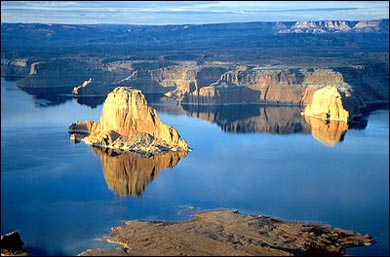THE WATER:
All About H2O
The wet stuff is always there for us—it grows our food, puts splash and spirit in our adventure, and (by the way) keeps us alive. for a special report on the health of America’s most vital resource.WATER CANON.
for a complete list of ���ϳԹ���‘s articles on American water, from William T. Vollmann’s filthy Salton Sea journey to the new hero of the Mississippi.
Colorado River
File Under: Toxic threats The Case: Since 1997, 1.7 million tons of perchlorate—an ingredient in rocket fuel—has leached from defense-industry sites and turned up in groundwater and crops in Southern California irrigated by the Colorado River. A 1999 EPA report suggests that four to 18 parts per billion of perchlorate should be considered dangerous, and numerous studies have linked the substance to tumors and thyroid pathologies in adults. Meanwhile, some sections of the Colorado have perchlorate levels up to nine parts per billion. The Crystal Ball: In April, the Bush administration reportedly told EPA officials not to talk about perchlorate until the National Academy of Sciences completes its review of the chemical. California senator Barbara Boxer, who has introduced two bills on perchlorate contamination and a community’s right to know about it, plans to keep pushing on the issue. “I will continue to fight attempts by the Department of Defense to be exempted from state and federal hazardous-waste cleanup laws,” she says, “so that taxpayers and local water districts don’t have to bear the burden of cleaning up someone else’s mess.” Contact: Environmental Protection Agency, 202-272-0167,
THE WATER:
Mattaponi River, Virginia
File Under: Threatened wetlands The Case: Eastern Virginia’s Mattaponi River, a tributary to the York River and one of the most pristine coastal systems in the state, is the proposed site of a 1,500-acre drinking-water reservoir that would serve approximately 600,000 residents in four counties and four cities. Two serious problems: First, constructing the reservoir, which involves building a 70-foot-tall, 100-foot-wide earthen dam, would destroy 400 acres of wetlands—potentially the largest single wetland loss in Virginia since 1972. Second, the local Mattaponi and Pamunkey tribes fear the reservoir would adversely affect shad populations, which they rely on for food. The Crystal Ball: Newport News mayor Joe Frank hasn’t presented an alternative to the reservoir, but local activists have come up with a few of their own. They argue that water needs could be met by dredging existing reservoirs, using water from nearby cities, or desalinating ocean water. Contact: Virginia Marine Resources Commission, 757-247-2200, THE WATER: Yuba River, California
File Under: Endangered habitat The Case: The California State Water Resources Control Board released a decision in 2001 that could require the Yuba County Water Agency to let out up to 1,000 more cubic feet of water per second than what was required in a 1965 agreement—a move lauded by conservation groups and booed by the Yuba County Water Agency. The YCWA wants the water for its customers—local townships and irrigation farmers. Conservation groups want to preserve one of the best remaining chinook salmon and steelhead runs in the West. “This is a classic water dispute, and stuck in the middle are the poor fish,” says Chuck Bonham, an attorney with Trout Unlimited. The Crystal Ball: Currently, the decision is tied up in litigation, and it may be months before the fish actually get any water. Contact: Trout Unlimited, 800-834-2419,
THE WATER:
Maalaea Bay, Maui, Hawaii
File Under: Reef destruction The Case: The U.S. Army Corps of Engineers has a plan to extend an existing breakwater in this harbor by an additional 466 feet, turning the wind-whipped Maalaea Bay into a safer and larger area for boaters. But in order to build the $16 million concrete-and-rock buffer, workers will have to blast through 4.8 acres of living coral reef—home to 120 marine species, including endangered hawksbill turtles—possibly altering the Maalaea Freight Train, the world’s fastest ridable wave. The Crystal Ball: Surfrider Foundation is raising funds to hire independent consultants to review the Corps’s plan, and will go to court if necessary. Contact: Surfrider Foundation, 949-492-8170, ; Sierra Club Maui Chapter, 808-579-9802,
THE WATER:
Gunnison River, Colorado
File Under: Whitewater war The Case: Thanks to rapid population growth along Colorado’s Front Range (the area is expected to double in population in the next 40 years), developers want to tap the Gunnison River for their future water needs. But more water withdrawn from the Gunnison could choke Black Canyon—a popular stretch of whitewater in the Rockies. Local paddlers are riled. The Crystal Ball: Front Range growth isn’t slowing down, but the answer is not to siphon off more surface water. “If Front Range residents would use water more efficiently, they wouldn’t need to take it from the Gunnison River,” argues Drew Peternell, a Trout Unlimited attorney. Contact: Trout Unlimited, 800-834-2419,
THE WATER:
Deschutes River, Oregon
File Under: User conflict The Case: Of the 28 U.S. rivers that have management plans requiring permits for use, the Deschutes is the only one that has not implemented a permit system. Commercial guides love the status quo, but private boaters are suing state parks to introduce a first-come, first-served plan that would issue permits and manage the traffic on this wild waterway. Private boaters are willing to take a chance on regulated (and possibly reduced) access if it means they won’t play second fiddle to commercial outfitters. The Crystal Ball: For the past six years, the BLM and local government agencies have failed to approve a permit plan, and it’s unlikely they will anytime soon. Contact: National Organization for Rivers, 719-579-8759,
THE WATER:
Rio Grande, U.S.-Mexico Border
File Under: International incidents The Case: Since late 2000, the U.S. government has locked horns with the Mexican government over water use along the 1,885-mile Rio Grande, more than 800 miles of which forms the U.S.-Mexico border. Mexico currently owes the U.S. 326 billion gallons of Rio Grande water, according to allotments designated in a 1944 water-sharing treaty. The debt, exacerbated by severe drought in the region, has angered Texan farmers in need of water. The Crystal Ball: Mexico is water-strapped and will most likely default on a large part of the debt. Bottom line: Until it rains, the lion’s share of owed water will have to wait. Contact: American Rivers, 202-347-7550,
Big Wins
Now for the good news. Though water disputes often wind up in court—and never leave—here’s something really refreshing: seven worthy fights that had a beginning, middle, and happy ending.
Worth Saving: Droplets
Ratio of extinction rate for North American freshwater animals to that for land animals: 5:1Less than one: Percentage of U.S. ocean areas granted full federal marine protection status
50: Estimated percentage of U.S. threatened and endangered species that depend upon wetlands
50+: Percentage of U.S. population living in counties that border one of our coasts
Amount of the earth’s surface freshwater in the Great Lakes: 18 percent
Area of U.S.-controlled ocean [in square miles]: 4.5 million
Sources: American Rivers; Pew Oceans Commission; U.S. EPA; NOAA; National Audubon Society
THE WATER:
Gauley River, West Virginia
File Under: Victory for paddlers The Case: The U.S. Army Corps of Engineers has managed the gates of West Virginia’s Summersville Dam since the 1960s. Local rafters got water time on the 26-mile stretch, covered with more than 100 Class III-V+ rapids, only if they were lucky enough to be on the river during a random release. In the mid-1980s, rafting outfitters, hoping to spark the region’s flagging economy, convinced the Corps to arrange a release schedule for six weekends every fall. Business has been brisk ever since, and the Gauley hosted the 2001 World Rafting Championships—a first in the U.S. Will it stick? Yes. The whitewater industry brings in $9 million to $10 million to the local economy during the fall releases. Contact: Class VI River Runners, 800-252-7784,
THE WATER:
Hudson River, New York
File Under: River cleanup The Case: Until the late 1970s, General Electric dumped toxic PCBs into the Hudson. But Congress’s 1980 Superfund Law mandating that corporate polluters pick up the tab for their own messes would put a stop to GE’s ways. In 2002, the EPA stuck GE with a whopping $490 million tab, which will cover the cost of dredging 40 miles of the upper Hudson. Will it stick? Very likely. Despite GE’s $22 million anti-cleanup advertising campaign, the EPA issued a 2002 Record of Decision mandating that the cleanup start in 2006. Contact: Riverkeeper, 800-217-4837,
THE WATER:
Orange County Coastline, California
File Under: Surf’s up again The Case: Since 1972, the Orange County Sanitation District had exploited Clean Water Act loopholes and spewed 240 million gallons of partially treated sewage—every day—into the Pacific Ocean. By 1999, bacteria counts had pushed above the legal limit in Huntington Beach, California (a.k.a. Surf City). The resulting beach closures shut out surfers until, fed up, they banded with environmentalists to petition for the return of clean waves. Their efforts spurred the OCSD to start a chlorination program last summer and to install a full-filtration system by 2013. Will it stick? Probably. The OCSD has been on board thus far. Contact: Surfrider Foundation, 949-492-8170,
THE WATER:
Kennebec River, Maine
File Under: Dam demolition The Case: Until four years ago, the Edwards Dam—a 25-foot-high, 917-foot-wide timber plug—blocked ten migratory fish species, including Atlantic salmon and endangered sturgeon, from spawning upstream. After a decade of fighting for fish rights, the Kennebec Coalition convinced the Federal Energy Regulatory Commission that the ecological consequences outweighed the benefit of the modest hydropower output, and in July 1999, FERC decommissioned the dam. Will it stick? Yes. Dam-removal momentum is picking up—since 1999, environmental groups have helped unplug more than 100 across the nation. Contact: American Rivers, 202-347-7550,
THE WATER:
Mono Lake, California
File Under: Lake resurrection The Case: For years, Los Angeles dipped its straws into tributaries that feed Mono Lake, causing water levels in the lake to fall, increasing salinity levels, and threatening insects and shrimp that are key to the food chain. With the ecosystem in danger in 1994, the Mono Lake Committee’s 16-year grassroots campaign persuaded the California State Water Resources Control Board to limit L.A.’s water rights and establish sustainable water levels for Mono Lake. Will it stick? Very likely. Lake levels are up eight feet and are expected to continue rising. Meanwhile, Los Angeles has initiated wastewater-recycling and low-flow-toilet programs. Contact: Mono Lake Committee, 760-647-6595,
THE WATER:
Salmon River, Idaho
File Under: Keeping it wild The Case: In 1988, the Forest Service permitted outfitter Norm Guth to construct four cabins and a lodge on the Salmon River, specifically on a pristine stretch along the Montana state line in the Salmon-Challis National Forest that was protected by the Wild and Scenic Rivers Act of 1968. The environmental organization Wilderness Watch cried foul, arguing that development is prohibited on any river protected by the act. After a 12-year legal crusade, the U.S. District Court in Montana ordered the removal of Guth’s Camp—now called Whitewater West (Guth sold the cabins a few years ago)—and the rehabilitation of the shoreline by 2005. Will it stick? Maybe. In the next few months, Idaho senator Larry Craig—who believes the cabins provide access to underused public land—will attempt to topple the court ruling. Contact: Wilderness Watch, 406-542-2048,
THE WATER:
Richland-Chambers Reservoir and Trinity River, Texas
File Under: Creative wetlands The Case: Faced with a population boom in the Dallas-Fort Worth area, the Tarrant Regional Water District constructed 240 acres of wetlands to channel river water into the Richland-Chambers Reservoir. The wetlands will provide a natural filtration system for pollutants between the Trinity River and the reservoir, serve as habitat for area waterfowl species, and meet the growing water demands for Dallas-Fort Worth. Will it stick? Yes. The pilot program is running without a hitch, and the TRWD plans to build 1,760 more wetland acres by 2010. Contact: Tarrant Regional Water District, 817-335-2491,
Jump In: How to Get Involved
GET ACTIVE
For more national and local water advocacy groups, .You might think water conservation groups have bigger concerns than your local creek. Not so. The work of their grassroots foot soldiers (that means you) can have the most immediate impact on a stream. Says Matt McClain, marketing director of the Surfrider Foundation, “We just want people to take ownership—become a member and volunteer, or pick up trash at your hometown beach.” Here are some ways to get involved. Pay the annual membership fee. Your dollars help fund research projects, advertising campaigns, lobbyists, and lawyers—lots of lawyers. Volunteer your time, and sweat a little. You could find yourself taking samples from local lakes, inviting experts on the Clean Water Act to speak about its finer points, or writing grants to sympathetic foundations. Commit democracy. Advocates propose local, state, and federal legislation (like that which protects endangered species’ habitats), speak at public hearings, and work with environmental groups’ national branches to devise policy campaigns to present to Congress. Listed below are organizations that need your help. WATER WARRIORS
AMERICAN RIVERS (202-347-7550, ) seeks to maintain the protected status of 160 rivers under the National Wild and Scenic Rivers System. Each spring, AR names America’s most endangered rivers; the 2003 list includes the Klamath River and the Rio Grande. Battlefront: fighting to preserve the Columbia River’s endangered wild salmon and steelhead populations.
AMERICAN WHITEWATER (866-262-8429, ) fights for recreational access to rivers and maintains an excellent database of current river flows on its Web site. Battlefront: the decommissioning of the Dillsboro Dam, on North Carolina’s Class II-IV Tuckasegee River.
EARTH ISLAND INSTITUTE (415-788-3666, ), founded by late enviro great David Brower, assists local environmentalists in preserving and restoring waters under siege, such as Russia’s Lake Baikal and Alaska’s Inland Passage. Battlefront: ending the cruise- ship industry’s practice of dumping sewage and other waste into U.S. oceans, which is still legal thanks to an exemption granted under the Clean Water Act.
NATIONAL AUDUBON SOCIETY (212-979-3000, ) works to protect wetlands, rivers, and lakes that are habitats for numerous bird species. Battlefront: revitalizing the Mississippi River’s adjacent wetlands from Lake Itasca, in Minnesota, south to Cairo, Illinois, to reestablish it as the major U.S. north-south flyway.
NATIONAL WILDLIFE FEDERATION (734-769-3351, ) works with U.S. and Canadian governments to curb water contamination in the Great Lakes and targets air polluters as the leading source of mercury contamination in the Great Lakes basin. Battlefront: stopping Lake Michigan from shrinking; excessive urban demand has dramatically reduced water flow into the lake.
NATURAL RESOURCES DEFENSE COUNCIL (212-727-2700, ) litigates to protect drinking water, works to create marine preserves to stop on- and offshore development, and fights to enforce water-rights laws across the western U.S. Battlefront: attacking attempts by the real-estate-development, oil, chemical, agriculture, and mining industries to rewrite the Clean Water Act and weaken protections for some 80 percent of the nation’s water. Their efforts would reopen trout streams, wetlands, and headwaters to pollution.
OCEAN CONSERVATORY (202-429-5609, ), with more than 900,000 members and volunteers around the world, protects newly discovered marine species and organizes International Coastal Clean-Up Day each September. Battlefront: combating overfishing; in the last 50 years, commercial harvesting has reduced large-fish stocks by 90 percent.
SURFRIDER FOUNDATION (800-743-7873, ) concentrates on coastal conservation and water quality, with an eye toward maintaining clean water and recreational access to surf breaks. Battlefront: establishing a marine reserve at Tres Palmas, a surf break near Rincon, Puerto Rico, that’s home to the Caribbean’s last large expanse of elkhorn coral.
WATERKEEPER ALLIANCE (914-674-0622, ), founded in 1992 by Hudson River fishermen, is now a global collective of 114 groups (with alliances in Bolivia, Costa Rica, and the Czech Republic) assigned to protect entire watersheds. Battlefront: halting mountaintop removal mining in Appalachia, which leaches mercury into the water table.
Water Heroes

 Barry Dana: The River Voice
Barry Dana: The River Voice
The Law Man
Colorado Supreme Court justice Gregory Hobbs calls CHARLES WILKINSON “the poet of western water laws.” While the 63-year-old University of Colorado law professor does have a way with wordshe wrote the lyrical conservation classics Fire on the Plateau and Crossing the Next Meridian: Land, Water, and the Future of the WestWilkinson also carries a big policy stick. “He is a very powerful and weighty voice on every issue he gets involved in,” says Simeon Herskovits, 39, an attorney with the Taos, New Mexico-based Western Environmental Law Center. Wilkinson was a key consultant on environmental issues for the Clinton administration and is now working on plans to scale back massive water-diversion projects in Colorado and the Southwest, and building support for demolishing dams, like the four behemoths on Washington State’s Lower Snake River. Though President Bush ixnayed that idea, Wilkinson is still optimistic. “In water law, you can’t think in four-year segments,” he says. “Those dams are stupid, and they’re going to come out.” Spoken like a true poet.
JAMES GLAVE
The Surf Warrior
In the mid-1990s, San Diego-based water activist and surfboard-shop co-owner DONNA FRYE noticed many surfers complaining of strange symptoms, from rashes to eye infections to numbness in their limbs. Frye, 51, suspected that the problem was in the water. She was right: Storm drains, pesticide-treated crops, and leaking septic systems were all running straight into the ocean, in many cases at prime surf breaks. In 1995, she established Surfers Tired of Pollution (STOP) and began mapping the location of storm drains, lobbying in Washington for clean-water legislation, and working on local water policy. Her efforts have paid off. San Diego posted warning signs at drain locations and has cleaned up its act86 percent of the city’s 102 beaches were rated good to excellent by a local enviro group. In 2001, Frye was elected to the city council, where she’s now waging a battle against a planned expansion of SeaWorld in Mission Bay and working to create the San Diego River Park. “The politics of pollution don’t intimidate me at all,” says Frye. “I just want to give the public back their ocean.”
MICHAEL HOYER
The Fighting Spirit
When Hudson Riverkeeper ALEX MATTHIESSEN, 39, isn’t patrolling the Hudson in his motorboat to catch polluters in the act, he’s filing lawsuits. In three years as executive director of the Garrison, New York-based Riverkeeper, dedicated to protecting the Hudson River watershed, Matthiessen, son of writer Peter Matthiessen, has transformed the group from a squad of 11 to a company of 22 staffers, prosecuting more than 130 cases against Hudson polluters annually. In February he helped win the largest Clean Water Act award ever when New York City coughed up a $5.7 million penalty for discharging sediment into Esopus Creek, part of a watershed that serves nine million people. Now he’s trying to decommission the Indian Point nuclear facility, a potential terrorist target 22 miles north of Manhattan. But he claims his greatest contribution has been recruiting 15 local Hudson watchdog volunteers. “If we’re going to change the way we think about water protection, everyone has to be part of the dialogue,” he says. “It’s going to take a citizens’ army to do that.”
KATE SIBER
The Mad Professor
When TYRONE HAYES, a 36-year-old biologist at the University of California at Berkeley, first started dating, he would take women out to the swamp to collect frogs. These days he’s married and has a small army of eager students catching the critters from Montana to East Africa. “Amphibians’ permeable skin makes them particularly susceptible to pollutants,” says Hayes. “That’s why I’m using them as a tool.” Five years ago, he uncovered evidence suggesting that atrazine, the most widely used weed killer in the world, stunts development of male frogs’ larynxesdisastrous for any young hopper who wants to call for a mate. Though the world’s leading atrazine producer, Swiss chemical company Syngenta, commissioned Hayes’s original study, it is now trying to counter his findings. Even so, Hayes has succeeded in drawing attention to the herbicide’s potential dangers, including the possibility it could cause cancer in humans. He is currently conducting amphibian studies on the North Platte and Missouri rivers.
��.��.
The River Voice
In the late 1980s, BARRY DANA, 44, a member of the Penobscot tribe of Maine, established an outdoor education center on an island in the Penobscot River to teach kids outdoor living skills. But when students began to develop headaches and rashes from air- and waterborne pollution discharged by the nearby Lincoln Pulp and Paper Mill, he was forced to move the camp. A decade later, Dana, now chief of the Penobscot Nation and a national champion whitewater canoeist, is leading a fight to stop paper mills from dumping a toxic cocktail of dioxins and PCBs into the river. “I want the mills to have zero discharge into the river,” says Dana, “and I want them to lay claim to producing the most environmentally sound paper in the world.” It hasn’t been an easy fight, since the paper industry is a major political force in Maine. Dana’s been threatened with jail time, cited with contempt of court, and thrust into a complex legal debate over tribal sovereignty. But for the chief, it’s all just part of the job: protecting his people and their waters.
SAM BASS


